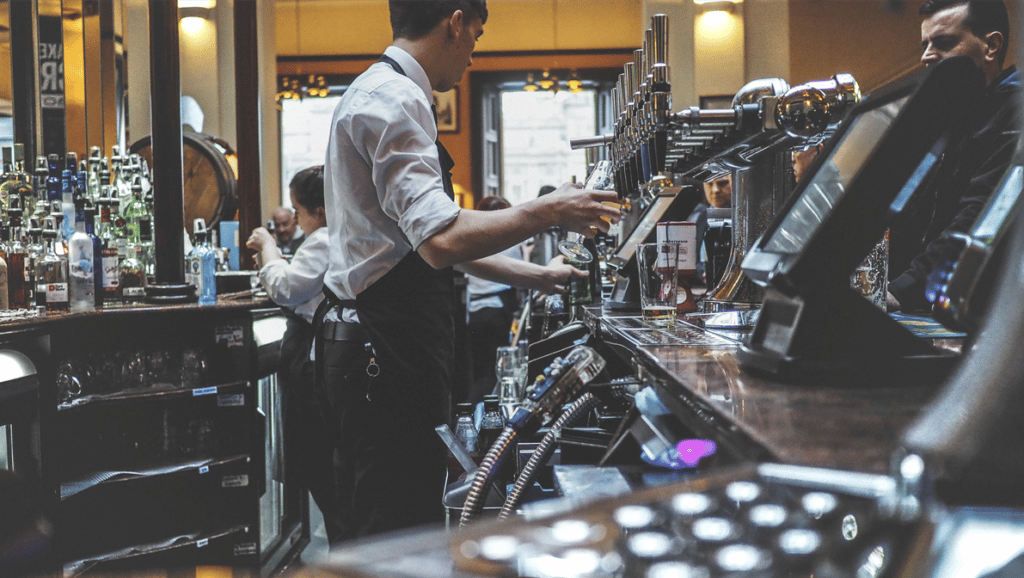Your labor cost is one of the highest expenses for your restaurant, typically taking up to 25-35% of revenue.
Many factors can increase restaurant labor costs: inefficient schedules, overtime hours, or even rising wages. Because sales and labor needs can change by the hour, day, week, and month, it can be difficult to control your labor budget over time.
However, store managers can optimize labor costs if they have access to the right data. With the help of actionable data and reporting, store managers can help control labor costs, without negatively impacting the customer experience or employee retention rates.
Store-level restaurant managers should be aware of labor cost challenges, as well as the tools that can add efficiencies.
If you want to understand the details of your labor costs at the store level, here are some fundamental concepts and metrics to track.
Total labor cost
Your restaurant labor cost includes everything your restaurant spends on labor, from salaries and hourly wages to payroll taxes, bonuses, and benefits like health insurance or vacation days. Your total labor cost is a dollar figure that may shift over time as sales fluctuate (we’ll discuss calculating this labor cost as a percentage below).
Here are a few helpful labor cost terms, along with how they are related to your total labor cost.
Hourly Employees
Your hourly employees are the staff members who work for hourly wages—in a typical restaurant, this usually includes all employees except managers. These labor hours represent an area of your labor cost that is largely under your control. Streamlining how you schedule hourly employees can have an enormous impact on your labor cost.
Salaried Employees
Your salaried restaurant employees are likely the staff on your management team. The cost of your salaries is relatively fixed, but there is still the opportunity to examine how you use your salaried employee hours. Manager hours can be used to fill in certain responsibilities at certain parts of the day, allowing you to save hourly employee budgets for the optimal parts of the day.
However, although many restaurants have historically used managers as support staff, this may not benefit certain long-term retention goals. Finding the right balance of hours and expectations that benefit your labor cost is key.
Overtime
Overtime pay, usually coming in at least 1.5 times the regular pay rate of an hourly employee, can quickly start to increase labor costs for a restaurant. Many restaurant owners and operators try to run a zero-overtime policy.
Even if it’s just a little each week, employee overtime can add up quickly, leading to a large impact on your bottom line over a month or quarter. Most restaurants aim to use employee scheduling or labor tracking tools that can catch overtime in the labor data, correcting issues before they happen.
Burdened vs. Unburdened Labor
When analyzing your labor data, there are two different kinds of labor you can track.
Unburdened labor is the direct cost of scheduled shifts—what you pay in wages. Fully burdened labor accounts for your salaried and hourly wages, as well as other labor-related costs like payroll taxes, benefits, worker’s comp, medical insurance, overtime, etc.
Using fully burdened labor costs in your labor analysis, rather than unburdened labor costs, can help you get a full picture of your expenses. You can account for the entire cost, avoiding any surprises in restaurant accounting at a later point.
Labor productivity metrics
Your total restaurant labor cost can help you examine how much you spend on labor to produce revenue for your restaurant. However, this labor cost data can be even more helpful when it is broken down into more granular percentages and metrics.
If you have a restaurant management system that integrates fully with software like your point of sale (POS) and scheduling systems, you can use this data to easily calculate many of these metrics. Having all these tools in one solution allows you to pull data seamlessly and apply it to restaurant operations more regularly.
Here are a few of the most common metrics you can use to examine labor productivity.
Labor Cost as a Percentage of Sales
Because your actual dollar amount for labor cost can fluctuate day-to-day, restaurants typically calculate labor cost as a percentage of sales. Your labor cost percentage represents how labor hours are tracking with your sales (revenue).
Your total labor cost should include “fully burdened labor,” as explored above. You can calculate your labor cost as a percentage of sales for a specific period using this formula:
Total Labor Cost / Total Sales = Labor cost as a percentage of total sales
Your data should be accessible through your labor reporting tools. By pulling sales from your point of sale (POS) system, as well as labor reports, you can quickly calculate your labor cost as a percentage of sales.
This data can even be broken down into individual time periods. Understanding your labor cost as a percentage of sales on an hourly, daily, and weekly basis can help you spot trends and see what day parts you can improve.
Labor Cost Per Staff Role
In addition to overall restaurant labor cost as a percentage of sales, you can examine your labor cost by staff role.
You can divide up your restaurant staff costs in many ways, such as the cost of hourly versus salaried wages, or front-of-house versus back-of-house.
Detailed costs show what each role is contributing to your total labor cost. By understanding how your labor cost differs across teams, you can take a more granular approach to optimizing labor, team by team. And as you understand the differences between staff, you can also set and track labor percentage goals by role.
Sales Per Labor Hour (SPLH) and Customers Served Per Labor Hour
Your sales per labor hour (SPLH) tracks sales alongside your labor hours. SPLH is one of the key indicators of labor productivity. It tracks which service times are the most productive, and which can be improved. This same concept can also be applied to the number of guests you serve per labor hour.
With information from your POS system, you can track time for staff alongside sales reports (or customers served). A low SPLH may indicate employee scheduling issues like overstaffed shifts. A high SPLH may hint that your shifts are understaffed, which can result in poor customer service or negative employee morale.
Understanding the optimal goal for SPLH or guest count, broken down by day part, can help you maximize the results of your labor spend.
Sales Per Server Hour
You know that your front-of-house team is critical to healthy sales levels and a positive customer experience. But how do you track FOH performance over time?
In addition to your sales per labor hour, you can get even more detailed than SPLH by calculating your sales per server hour. This is calculated by dividing total server sales by the number of service hours worked.
Sales per server hour data can help showcase the efficiency of your servers. If the numbers could use improving, you can consider store-level training, such as a refresher on how to upsell tables. Training servers on how to suggest food and drink pairings can help maximize sales.
In addition, once you understand your sales per server hour, you can analyze any potential issues with overstretched staff that can result in negative customer service. If servers are having issues with table turnover rate, you may need to adjust goals for this metric. And if your service standard is very high, as with fine dining, your sales per server hour may look different than if you are a quick-table-turn family restaurant.
Average Sales Per Server
Average sales per server differs from sales per server hour. Sales per server hour can help you look at the entire team. However, it doesn’t track the success of individual team members. Examining average sales per server can help you examine individual team member performance.
Calculate the average sales per server by dividing total sales for an individual server by the total number of guests served by that same individual. By comparing these data points, you can understand how effective a server is at upselling or maximizing sales.
This metric can help you leverage your high-value restaurant employees in your scheduling. Your servers with the highest average sales should be scheduled during peak business hours to increase your revenue, while improving your margins on restaurant labor cost.
However, it’s important to note that the highest average sales aren’t necessarily always the goal. There is a balance between optimal sales levels and optimal customer service. You may also need to consider the scheduling requirements of your servers, who will need to work enough hours to make a living without experiencing burnout. Without these considerations, you may otherwise experience high turnover. As always, it’s necessary to look at these numbers in context.
Using these metrics to optimize labor costs
All these metrics, when applied with other technology tools, can help you reduce labor costs at the store level.
First, optimizing employee scheduling by using sales forecasting is one of the main tools you have at your disposal to optimize labor costs. Forecasting projects future sales levels, based on historical sales data from your POS. By using data from comparable time periods, you can project sales and the labor needed to meet those sales.
Forecasting is making schedules based on data, which allows you to follow suggested schedules that are based on sales per labor hour (SPLH) percentage goals.
Next, your data should drive your labor decisions on a regular basis. If you wait to check labor trends on a monthly or quarterly basis, the cost overruns can add up over time and affect the bottom line. Consistent, real-time analysis of your labor costs can help you address any issues as they arise.
For example, using a daily labor report that calculates labor cost as a percentage of revenue, in addition to SPLH, gives store managers the tools they need to make employee scheduling changes. If you track whether you’re meeting labor percentage goals in real time, you can use breaks, cuts, and call-ins strategically. Other tools, like overtime alerts or employees hitting an hour-per-week limit, can help managers stay on top of labor costs.
Finally, the metrics about labor productivity, or labor cost per staff role, can help you analyze where you may be able to add in efficiencies in your staffing. Whether it’s cross-training roles, like a server also acting as a bartender during a slow lunch shift, or scheduling your all-star sales team for the busiest nights, understanding metrics about your restaurant staff can help you make smarter decisions.
Conclusion
Every store manager should be tracking restaurant labor costs, from the nitty-gritty details to the high-level metrics. With the right technology tools, store-level managers have access to data-driven tools that can optimize labor costs.
If you would like to easily track labor data and gain insight into your operations to increase efficiency and boost profits, consider a comprehensive, restaurant-specific management solution. Restaurant365 is an all-in-one restaurant management system incorporating reporting tools, restaurant accounting software, restaurant operations software, inventory management software, payroll + HR software, and scheduling software into a cloud-based platform that’s fully integrated with your POS system, as well as to your food and beverage vendors, and bank.



